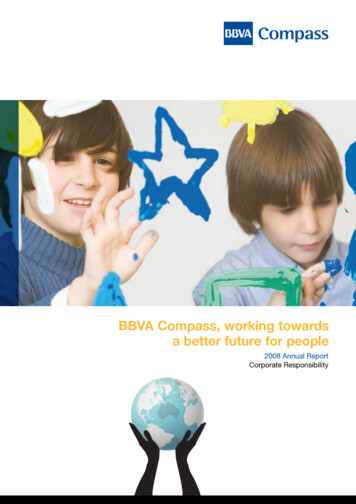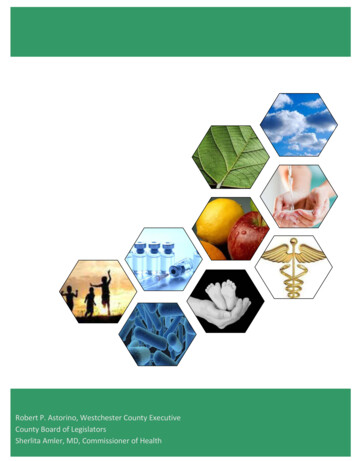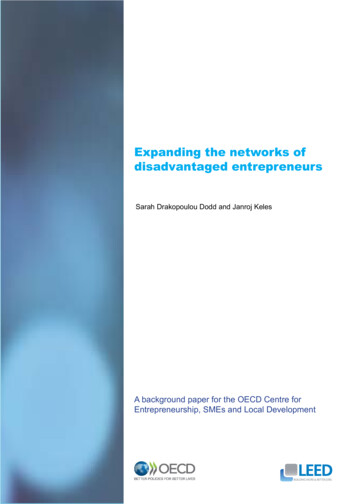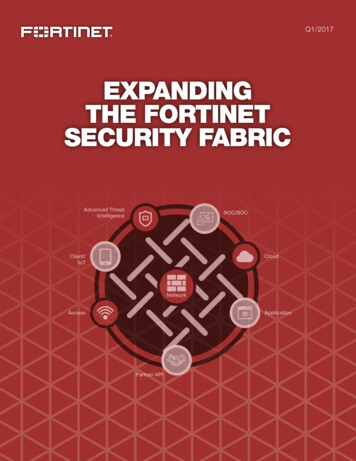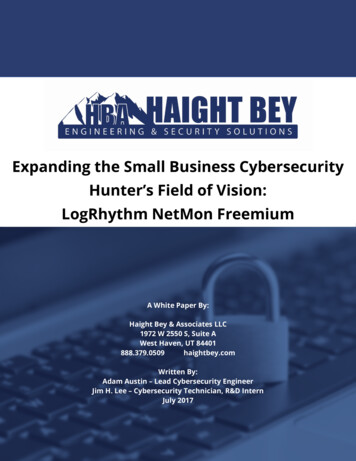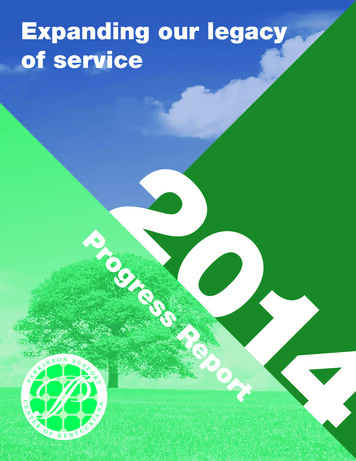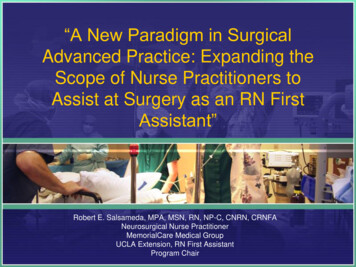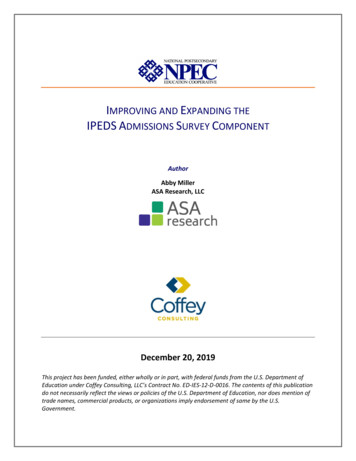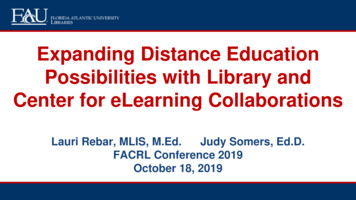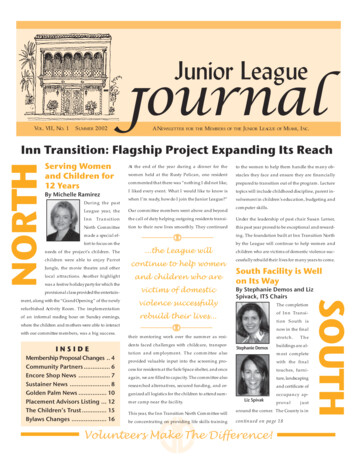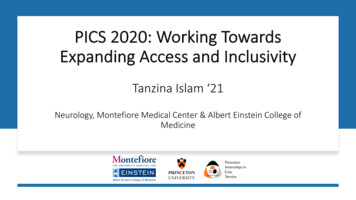
Transcription
PICS 2020: Working TowardsExpanding Access and InclusivityTanzina Islam ‘21Neurology, Montefiore Medical Center & Albert Einstein College ofMedicine
Internship Description Mainly worked with Dr. Correa Epilepsy Bioinformatics Study for Antiepileptogenic Therapy(EpiBioS4Rx) trial Public Engagement Core (PEC) address barriers and facilitators to clinical researchparticipation Expanding access & ensuring inclusivity
Overview Selected Projects Systematic Review: Use of remote consent in Intensive Care Unit (ICU)clinical research Advocacy writing Summary of other summer work Reflections Next steps
Systematic Review: Remote Consent inICU Research Studies Systematic Review: Identify, evaluate, and summarize findings of all relevant studies on a topic Our Topic & Purpose Analyze the use of remote consent in the ICU for clinical research participation telephone/smartphone, video Relevance Expand access to clinical trial participation include a broader sample through remote technologies (Bunnell et al., 2020) COVID-19 pandemic remote consent may support continuation of clinical research (Rai & Frei, 2020)
Systematic Review: Remote Consent inICU Research Studies Initial Search Process Databases searched: PubMed, Embase, Web of Science Inclusion criteria Remote consent obtained in: ICU or emergency/prehospital setting (receive critical care within 48 hours) Studies conducted after December 1999 50% U.S. pop. has access to internet No restrictions on age, sex, language, and region (i.e. worldwide) Worked with an Einstein College of Medicine librarian
Search Modifications &Planned Workflow Modifications Time restriction: (2005 – present) 68% U.S. pop. has access tointernet At least 50% access acrossracial groupsFigure 1: Workflow Diagram
Valuable Studies: Data ExtractionRemote Recruitment RateRemote Consent thodTelemedicine-guided remote enrollmentof patients into an acute stroke trialWu, 2015strokeaudiovisual66.67% (6/9)66.67% (6/9)Honarmand,2016myocardialinjuryaudio92.5% (37/40)92.5% (37/40)Saver, 2006strokeaudio100% (20/20)100% (20/20)Sanossian,2009strokeaudio34.6% (18/52)34.6% (18/52)Switzer, 2010strokeaudiovisual100% (19/19)10.5% (2/19)The Deferred Consent Model in aProspective Observational StudyEvaluating Myocardial Injury in theIntensive Care UnitPhysician-investigator Phone Elicitationof Consent in the Field: A Novel Methodto Obtain Explicit Informed Consent forPrehospital Clinical Research - (FASTMAG)Simultaneous Ring voice-over-InternetPhone System Enables Rapid PhysicianElicitation of Explicit Informed Consentin Prehospital Stroke Treatment Trials (FAST-MAG)A Telestroke Network EnhancesRecruitment into Acute Stroke ClinicalTrials!"!# # &"'()'!)*!"!# # ),"!) -'!) #&!-"'* (100)!"!# # ),"!) 4 &"'()'!)*!"!# # ),"!) -'!) #&!-"'* (100)
Advocacy Writing: Teleneurology Telehealth use during Covid-19 Many institutions have turned to telemedicine (Hollander & Carr, 2020) Covid-19 has shown acute neurological complications (Asadi-Pooya & Simani, 2020) long term effects? importance of continued remote follow up Important to consider pre-existing socioeconomic and infrastructure disparities particularly in Bronx populations (Stringer, 2014) 21% of residents do not have a computer at home 13% do not have a subscription to internet access internet/smartphone access limited in Black & Hispanic populations
Advocacy Writing: Teleneurology Collaborated with other authors to raise awareness about this issue Access to care matters: Remote Healthcare Needs in the Bronx During Covid-19 Call to actions Expand and provide open access to telehealth training for neurologists Screen for and address needs of patients facing socioeconomic insecurities technological resources, broadband internet services, digital literacy Ensure telehealth services are permanently covered by insurance providers
Additional Projects: Access andInclusivity Advocacy pieces: Remote Clinical Exposure Experiences: Fortifying the MedicalEducational Pipeline During Covid-19 and Beyond Expanding paid sick leave as a public health tool in the Covid-19pandemic PEC projects: Stakeholder involvement in focus group and questionnairedesign
Reflections Grateful to work on issues facing my own community Was able to deeply explore and consider disparities familiar to me Developed academic & professional research and communications skills Database searching, article review, scientific writing Enabled personal development through career planning
Next Steps Continuation of these these projects and my partnership with Dr. Correa Find new methods of involvement & advocacy to address these issuesapparent in my community Integrate these issues/ perspectives into my professional plans (medicalschool and beyond)
AcknowledgementsI would like to thank Dr. Correa,the many research collaboratorsI had the opportunity to workwith, and Dr. Binder for all theirguidance and help this summer.
References1) Bunnell, B. E., Sprague, G., Qanungo, S., Nichols, M., Magruder, K., Lauzon, S., et al. (2020). AnExploration of Useful Telemedicine-Based Resources for Clinical Research. Telemed J E Health, 26(1),51-65. doi: 10.1089/tmj.2018.02212) Rai, A. T., & Frei, D. (2020). A rationale and framework for seeking remote electronic or phone consentapproval in endovascular stroke trials - special relevance in the COVID-19 environment and beyond. JNeurointerv Surg. doi: 10.1136/neurintsurg-2020-0162213) Asadi-Pooya, A. A. and L. Simani (2020). "Central nervous system manifestations of COVID-19: Asystematic review." Journal of the Neurological Sciences 413: 116832.4) Hollander, J. E. and B. G. Carr (2020). "Virtually Perfect? Telemedicine for Covid-19." New England Journal ofMedicine 382(18): 1679-1681.5) Stringer, S. M. (2014). "Office of the New York City Comptroller." 12.
Neurology, Montefiore Medical Center & Albert Einstein College of Medicine. Internship Description . Access to care matters: Remote Healthcare Needs in the Bronx During Covid-19 Call to actions Expand and provide open
